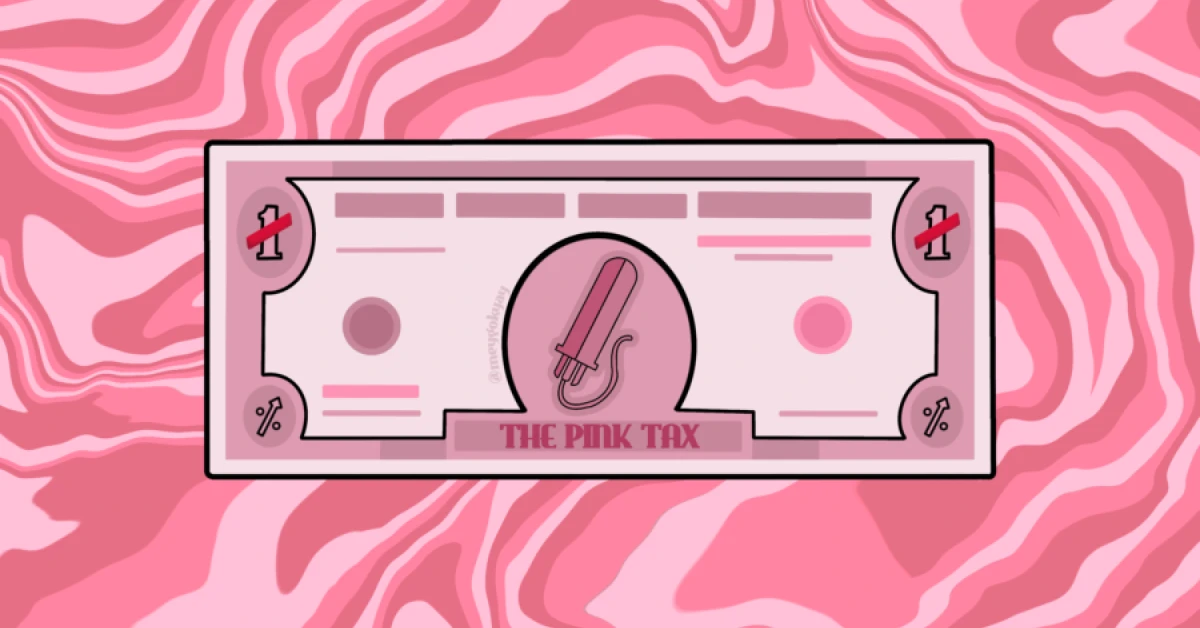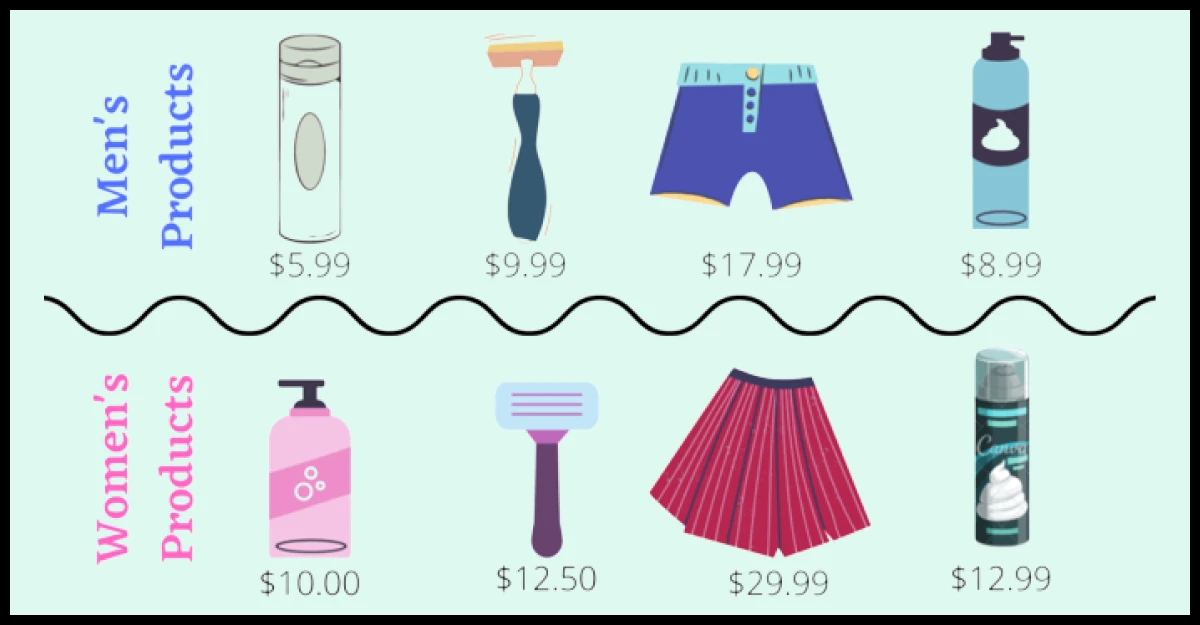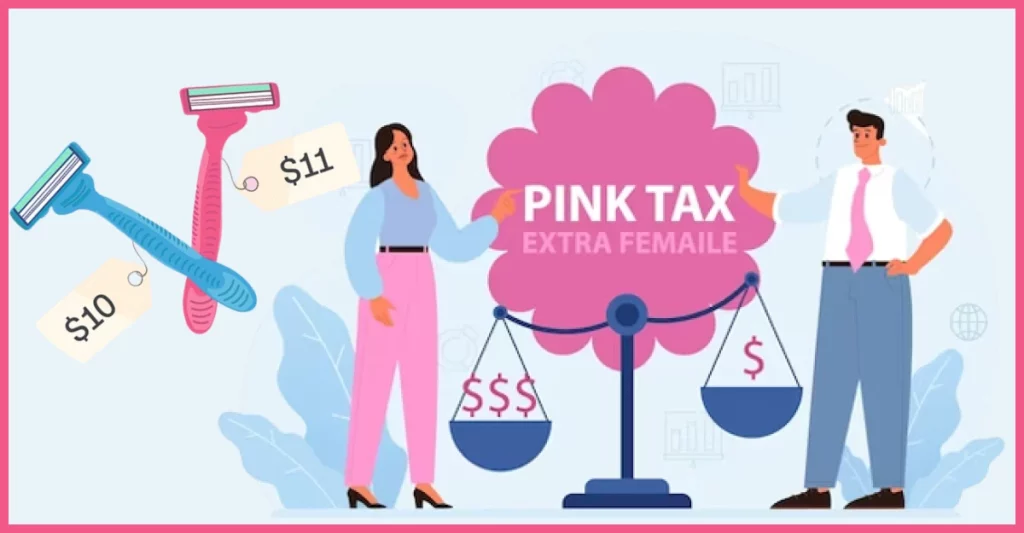Do you know only 23% of folks are aware of the pink tax in India? Are you one of them? If yes, that hats off to you… but if not, then this write-up is for you!
Let’s begin the concept of pink tax in India by considering some examples. Have you ever compared the products that serve the same purpose but are priced differently for men and women? A simple haircut costs Rs.40 for men and Rs.300 for women. Not only that, you will get plenty of such examples ranging from- grooming products (soaps, shampoos, razors, deodorants), laundry, dry cleaning, and fashion accessories, to apparel.

All these facts boil down to million-dollar questions- What is the Pink tax in India? What does it mean? Why do women pay higher prices for the same commodities? How does it affect women?
We will discuss every concept of Pink tax in India in detail. Stay tuned!
(A) What is the Pink Tax in India? Meaning & Concept
The term “Pink Tax” refers to the practice of charging higher prices for goods and services targeted specifically at women, often identical or similar to those marketed to men. This gender-based pricing discrepancy encompasses various products like personal care items, clothing, and services.
The government doesn’t impose any sort of pink tax. It is a common term referring to the systematic overpricing of products perceived as feminine, imposing an additional financial burden on women.
Sounds complicated? Let me explain it in simpler terms.
Picture this scenario- you stroll into a store, grab a razor, and whoops! The one in the pink packaging (women’s section) costs more than its blue counterpart (men’s section). That’s the Pink Tax in action.
Pay attention, readers! Pink Tax isn’t levied by the government officially on the goods aimed at women.
The term “Pink Tax” originated in California (USA) in the year 1994. There’s a story behind it which we will explore in the section of “History of Pink Tax.”
It’s like a secret fee women pay because their stuff is labeled “for women.” Now, let’s talk numbers. Recent data spills the tea – women end up forking out around 7% extra price thanks to the Pink Tax in India. Whether it’s shampoo or shirts, it’s this gender-based pricing game.
Sneaky, right?
Time to raise our eyebrows and question these extra charges!
Note: When it comes to taxes, you must have heard about GST (Goods & Services Tax). Although you might have a slight idea about it, do you know how it impacts our economy? To have detailed information, go through the article- “Impact of GST on the Indian Economy.”
(B) Current Scenario of the Pink Tax in India

Let me begin this section with a surprising fact. Only about 23% of folks in India have heard about the “pink tax”. And even fewer than them know about the impact of the Pink tax in India on the economy.
Now, get this – while male contraceptives get a free pass from taxes because they’re considered essential, feminine hygiene stuff like tampons and sanitary napkins get slapped with a 12–14% GST tax.
Why?
Well, our society tends to hold women to some high standards, pushing them to spend more on things like clothes, transportation, personal care, and makeup from a young age.
But here’s the kicker – it took some serious activism to get the Indian government to trim the GST on sanitary napkins from 12% in 2018.
Now, even though not everyone uses these products, recognizing them as part of the pink tax puzzle is crucial because it adds an unnecessary financial load.
In Hindi, Indians call it “Lahu ka Lagaan,” literally meaning “blood tax.” And when the finance minister announced that sanitary pads are 100% tax-free, it was hailed as a major win. Amar Tulsiyan, the Nine Movement founder, called it a victory for everyone fighting against period poverty, a global issue that hits women not just in India but worldwide.
(C) History & Timeline of Pink Tax in India
In this section, we will look into the history of the Pink tax from both global and Indian perspectives.
(C.1) History of Pink Tax Through Global Perspective
| Year | Event in the Globe |
| 1994 | Coined “Pink Tax” by American activist and author, Gloria Steinem. |
| 2014 | New York City Department of Consumer Affairs releases a study revealing gender-based pricing disparities. |
| 2016 | California passes a bill prohibiting gender-based pricing for services. |
| 2018 | Protests in India lead to the reduction of GST on sanitary napkins from 12% to nil. |
| 2019 | Procter & Gamble announces price cuts on some feminine care products in response to consumer pressure. |
| 2020 | The European Parliament calls for an end to gender pricing discrimination. |
| 2022 | India’s awareness of the Pink Tax stands at only 23%, according to research. |
Several nations, including Argentina, France, Germany, the UK, Australia, and Italy, have examined the pink tax phenomenon. In the UK, an investigation revealed that women and girls faced an average overcharge of 37% for toys, cosmetics, and clothing compared to their male counterparts.
Moreover, girls’ school uniforms in the UK were identified as being 12% more expensive than boys’ uniforms. Similarly, in Singapore, a survey of 10 companies by the Sunday Times uncovered that women were charged higher prices for certain products and services, such as dry cleaning and razors, by around half of these companies.
Additionally, women in Singapore encountered higher premiums for Careshield Life, a national long-term care insurance scheme implemented by the government.
(C.2) Indian Perspective: History of Pink Tax in India
| Year | Event in India |
| 2014 | Pink Tax in India gains attention in consumer goods. |
| 2015 | Discussions on gender-based pricing disparities rise. |
| 2017 | Reports reveal significant price gaps in various products. |
| 2018 | Persistent activism prompts the reduction of GST on sanitary napkins from 12% to address the Pink Tax. |
| 2019 | “Lahu ka Lagaan” (Blood Tax) term gains popularity, highlighting the issue in Hindi. |
| 2020 | Ongoing advocacy for fair pricing and awareness campaigns continue. |
| 2022 | Research indicates only 23% of Indians are aware of the term “Pink Tax.” |
| Present | Pink Tax remains a debated issue, sparking conversations on gender equality and consumer rights. |
Now, the question arises- What’s the cause of Pink Tax in India? Go through the next section and you will find out.
(D) Root Causes of Pink Tax in India
The Pink Tax in India has several causes, intertwined societal norms, and other economic factors. First, let’s have a brief overview of the reasons for Pink tax in India-
| Reason | Explanation |
| Gendered Marketing | Products are often marketed differently for men and women, and items labeled as “for women” tend to bear a higher price tag. This marketing strategy contributes to the Pink Tax by creating separate markets based on gender. |
| Societal Expectations | Deep-rooted societal expectations place a higher burden on women for personal grooming, clothing, and beauty products. This cultural norm influences consumer behavior, as women are socialized to spend more on these items, contributing to the gender-based pricing disparity. |
| Historical Tax Policies | Historical tax policies that exempt certain products as essential while taxing others as luxury items play a role. For instance, male contraceptives being exempt while feminine hygiene products face a GST tax adds to the Pink Tax phenomenon. |
| Lack of Awareness | A significant portion of the population remains unaware of the Pink Tax in India. Limited awareness contributes to a lack of consumer activism and pressure on businesses to reconsider their pricing strategies. |
| Slow Policy Changes | Despite some efforts to address the issue, policy changes have been slow. The reduction in GST on sanitary napkins in 2018 was a positive step, but broader policy shifts to eliminate gender-based pricing disparities are yet to be fully realized. |
In essence, the Pink Tax in India is a multifaceted issue rooted in societal norms, historical policies, and marketing practices that continue to shape consumer patterns and contribute to gender-based pricing discrepancies.
Addressing these causes requires a combination of awareness, advocacy, and policy changes to promote fair pricing and gender equality in the market.
Now, let’s delve into what the globe says about charging pink tax. As per the article in The Washington Post, women like to spend more money on improving their appearance. Also, some folks argue that products like Radio Flyer scooters cost more money because feminine paints like Pink or Peach color are more expensive which ultimately leads to the high cost of scooters designed for women.
Also, in dry cleaning, people say that men’s clothing is usually simpler and uniform due to which they are easy to clean.
Contrarily, women’s clothes have lots of variations and complex designs which makes the cleaning process complicated. That’s why women need to pay a high price for dry cleaning too.
Does it sound like a proper justification?
Absolutely not! Not all women’s clothes have too many complex designs. What if we give a simple women’s T-shirt at dry cleaning laundry, will they cost us less? Probably not.
So, the problem doesn’t lie in the designs but the prejudice against women.
(E) Impact of Pink Tax in India on the Women & Economy

In this section, we will shed light on how the pink tax in India impacts our economy-
(E.1) Financial Strain on Women
- Higher Expenses for Everyday Essentials: The Pink Tax in India results in women paying more for everyday items, such as razors, clothing, and personal care products, simply because they are marketed as “for women.” This places an additional financial burden on women, impacting their overall economic well-being.
- Unequal Economic Burden: The gender-based pricing strategy of the Pink Tax contributes to unequal expenses for identical or similar products, deepening the financial disparity between men and women. As per the Global Gender Gap Report 2022, women are already paid 19% less than men in sectors ranging from IT to agriculture. Also, in India, women earn 18% less than men.
(E.2) Reinforcing Gender Inequality
- Perpetuating Stereotypes: By assuming women are willing to pay more for certain products, the Pink Tax reinforces gender stereotypes. This not only affects individual budgets but also perpetuates the idea that women should bear higher costs for specific goods and services.
- Economic Inequality Amplified: Targeting women with higher prices amplifies economic inequality, conveying the message that gender-based pricing is acceptable. This contributes to existing disparities in financial access and resources.
(E.3) Consumer Rights and Awareness
- Limited Consumer Power: The Pink Tax restricts consumer power by unfairly pricing products based on gender. This undermines the ability to make informed and fair purchasing decisions, impacting consumer rights.
- Awareness as a Catalyst: Understanding the impact of the Pink Tax empowers individuals to advocate for fair pricing. Increased awareness can lead to collective efforts demanding change, promoting transparency, and holding businesses accountable for discriminatory pricing practices.
(E.4) Social & Psychological Implications
- Challenge to Gender Equality: The Pink Tax poses a challenge to gender equality beyond personal budgets. It signifies that gender determines the price one pays, perpetuating inequality and hindering progress towards a fair and just society.
- Advocacy for Change: Recognizing the social implications of the Pink Tax encourages advocacy for change. Questioning and challenging discriminatory pricing contribute to a movement aiming to dismantle barriers posed by gender-based economic disparities.
In short, the impact of the Pink Tax in India extends beyond financial strain, influencing societal norms and perpetuating gender inequality. All you need to do is to recognize this issue first and then advocate for system change to foster a more equitable economic landscape for women.
(F) Conclusion of Pink Tax in India

To sum up, Pink Tax in India means women pay more for everyday things, creating financial stress. It also keeps old ideas alive, thinking women should pay extra. This affects shopping power, making it unfair for women.
Understanding the Pink Tax will help you fight against it, promoting equal pricing. It’s not just about money; it challenges the idea that everyone should be treated the same. Recognizing this encourages speaking up for change, and breaking down barriers linked to unfair money differences.
The goal is a future where women aren’t burdened by unequal prices, fostering a fair and equal society in India!

